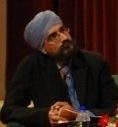KUALA LUMPUR, March 20 (Bernama) -- In less than four years of its inception, the IIUM Institute of Islamic Banking and Finance (IIiBF), has made tremendous progress.
This includes inking eight memorandum of understandings (MoUs) and collaboration with local, international private and governmental entities.
The International Islamic University of Malaysia (IIUM) rector, Datuk Seri Dr Syed Arabi Idid said today the areas of interest were mostly in training, research and consultancy, with some of the MOUs offering PhD programmes in Islamic banking and finance overseas, such as Bahrain.
The IIiBF would also introduce here a home financing scheme based on Musharakah Mutanaqisah, using the cooperative model in collaboration with Canada's Ansar Financing and Malaysia's Angkatan Koperasi Kebangsaan Malaysia Bhd.
"The IIiBF's vision is to aspire to become an international centre of excellence for education, research in Islamic banking and finance and this is in view of the rapid global growth and expansion of the industry.
"It is also due to the urgent need for capacity building, particularly in relation to balanced, knowledgeable, human resource and expertise as well as the mission of reviving the Ummah's competitive edge in economics and finance," he said in his speech at the soft launch of the IIiBF here.
The event was graced by Bank Negara Malaysia deputy governor, Datuk Mohd Razif Abdul Kadir.
Citing the McKinsey's World Islamic Banking Competitiveness Report 2007/08, Syed Arabi said the industry had been expanding at an annual rate of 15-20 percent and was at present in more than 75 countries with over 300 Islamic institutions worldwide.
Islamic assets are set to hit US$1.4 trillion by 2010 and a 25 percent growth for the same period, he said.
"Based on the asset employee ratio, the estimated global employment needs of the industry in 2007 was 91,995 and in 2020, it will be close to two million.This is an average of 135,000 staff per year," he highlighted.
Meanwhile, he said the growth rate of the Islamic banking industry was enormous in Malaysia at 18-20 percent.
He added that Bank Negara envisaged a 20 percent increase in the market share of Islamic banking institutions by 2010.
Syed Arabi said the IIiBF had recently come up with its five-year strategic plan until 2015, including offering academic courses like the PhD, professional certificate programmes, joint masters, as well as publications such as student dissertations and joint publications among academicians and practitioners.
He added that the IIiBF was also looking to innovate and develop new products, find joint research to commercialise new products and evaluate existing products for re-engineering.
Meanwhile, Mohd Razif said it was important for the industry to come up with a differentiation in products to attract customers and that the IIiBF could play a role in enhancing its development.
"This is where scholars come in. If we don't start now, it will not happen," he said, adding that, Malaysia had a comprehensive Islamic finance system with banks having an Islamic window while five more are full fledged Islamic institutions. -- BERNAMA
Subscribe to:
Post Comments (Atom)

1 comment:
HYE MR HAB, HEHE
-MARYAM AND ZEHAN
Post a Comment